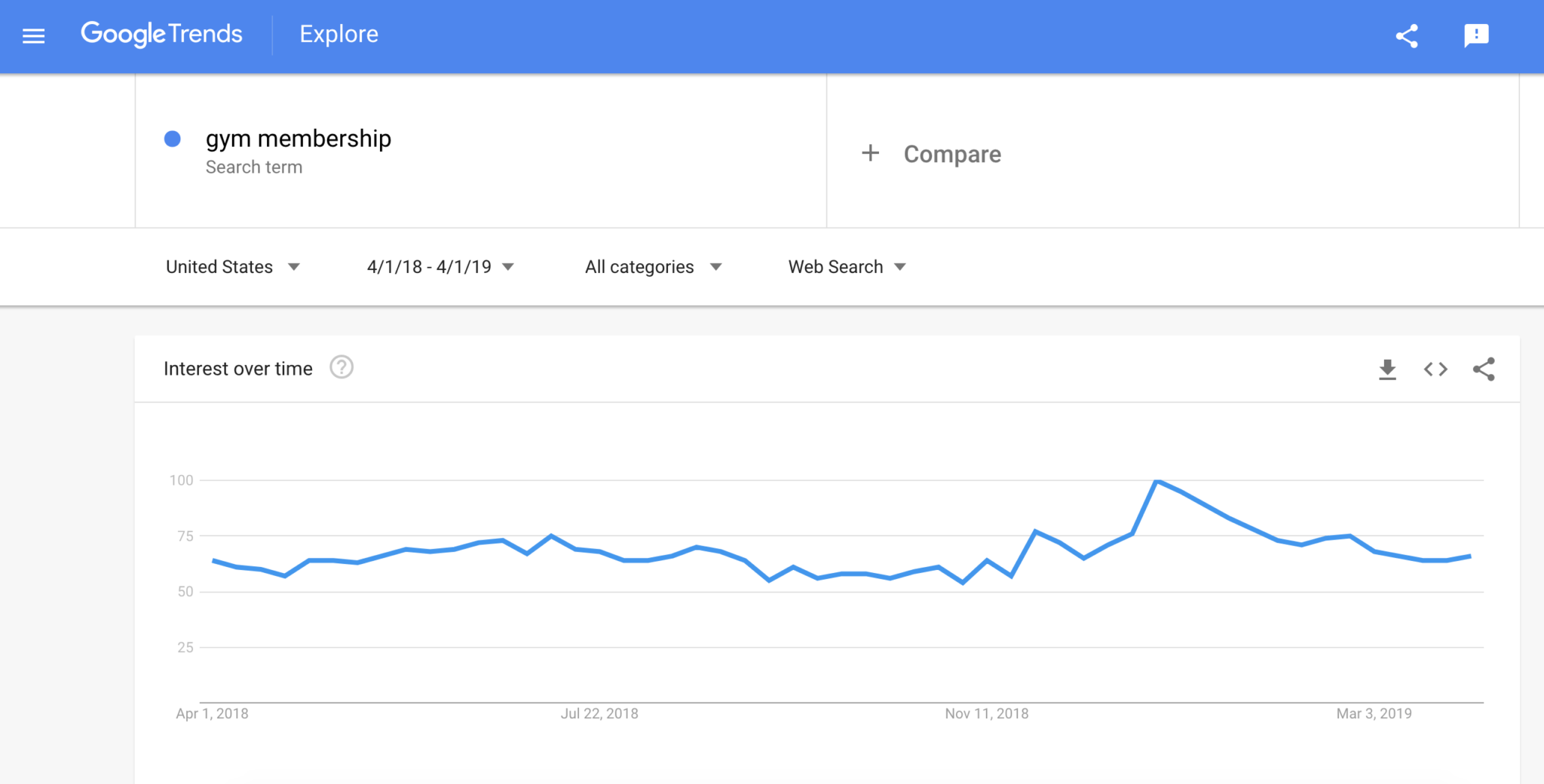Post-Christmas, many people are itching to make a fresh start in the New year. Especially when it comes to fitness. In this article, we’ll look at the new years resolution gym statistics you need to know if you’re a fitness business owner.
A survey conducted by NPR and The Marist Poll in 2018 showed that 44% of American adults said they were likely to make a new year’s resolution. Of those, a staggering 13% set out with the intention of exercising, making it the most popular resolution in the United States.
But that’s not all; the third and fourth most common new year’s resolutions were weight loss and healthier eating. That means that one in three resolution-makers hoped to achieve a health-related goal.
Of course, this is fantastic news for the fitness industry. Most fitness entrepreneurs start out to help people reach new fitness goals and lead happier, healthier lives, and as gym memberships begin soaring, January is your time to shine.
But as you’re probably aware, people’s intentions and people’s actions don’t always align. As the new year marches on, fitness goals can quickly fall by the wayside. And it’s the same every year.
But if you prepare with some killer strategies, your gym doesn’t need to be quiet at any time of the year. So, let’s take a look at some essential new year’s resolutions statistics and highlight how you can get ready for the influx of ambitious new members – and keep them motivated in the long-run.
Skip ahead to:
- 80% of Your New Members Will Quit Within 5 Months
- Group Fitness Can Slash Your Churn Rate by 50%
- 12% of Sign-ups Happen in January
- 56% Of Current Members Don’t like Your New Members
- Your Website Traffic Can Jump by 40%
- 'Fall off the Wagon’ Day
1. 80% of New Members Will Quit Within 5 Months
Research suggests that 80% of January gym-joiners quit within five months. As a studio owner, this means you’ll be missing out on a huge chunk of revenue over the latter half of the year. And that’s not good. Especially when you consider that it costs five times as much to acquire a new member as it does to retain an existing one. Just think about that for a second – the average gym membership in the United States sits at $58/month. In real terms, that’s an extra $348 per lapsed client that you’ve missed out on by December.
So, is there a way to combat the drop-off of members? Yes, there is; build a member onboarding strategy. Welcoming your new prospects into your club with a well-designed onboarding strategy can supercharge your retention rates. And it doesn’t take a tremendous amount of effort either.
Retention expert Dr. Paul Bedford showed that as little as four sessions spread over the first few weeks of membership can boost retention rates by as much as 17% at the 6-month mark.
And he’s not alone in his research either – the IHRSA’s 2018 report showed that just two interactions between staff and members each month increased attendance in the following month and caused a 33% reduction in risk of members canceling their membership.
That’s an incredibly significant statistic when you also consider the research from Frederick Reichheld of Bain & Company, who found that increasing member retention rates by 5% increased profits by between 25% and 95%.
So, consider building a new member welcome-protocol to help gym members transition from outsiders to valued members of your community. Keeping just a fraction of your new sign-ups from canceling can be the difference between struggling to keep the lights on and making plans to expand into a new city.
2. Group Fitness Can Slash Your Churn Rate by 50%
In addition to a solid onboarding strategy, introducing your new members to group fitness classes is a powerful tactic that reduces the chances of them canceling their membership.
In one study conducted at Penn State University, researchers started people who hadn’t trained before on a 30-week group fitness program. During the study, the intensity and frequency of workouts increased each week gradually.
In studies where people train on their own, the increasing difficulty of the program usually causes about 40% of participants to drop-out. But in this group exercise study, an incredible 98.8% of participants completed the program – an adherence rate that had been virtually unheard of in other fitness studies.
To further hammer home the point, another key finding of IHRSA’s 2018 report was that class attendees are 56% less likely to cancel their membership than those who go it alone on free weights or other training equipment.
It’s clear that the social support and increased accountability of group fitness can be just the ticket to motivate your new clients to push through the pain and stick to their resolutions. Consider promoting and incentivizing new members to sign-up to group fitness and watch your attrition rate take a welcome dive.
3. 12% of Sign-ups Happen in January
As you probably well know, January is the busiest time of the year for gym owners and personal trainers. According to IHRSA figures, 12% of all sign-ups happen at this time of year – which is proportionally more than any other month.
That means that you need to be ready for an influx of customers. It’s essential to get your staff roster in place early. Have your equipment serviced and working correctly and ensure that your computer system won’t crash on January 3rd.
The Customer
Engagement Playbook
for Your Fitness
Business
Discover more Start your marketing efforts early – but be smart about them. It’s tempting to offer a free trial to attract new members, but it’s more important that you value your business correctly. While it works for some, giving your services away for free can encourage trial hopping and devalue your brand. Offer incentives that provide value but require commitment. For inspiration, check out this article for three alternative methods to the free trial.
Depending on your capacity, it’s sometimes a wise move for gym owners to offer no discount at all. Think about it – the new year is a time when people want to exercise. You don’t need to seduce them with a financial incentive now – you can save that for later in the year when you don’t have mince-pie filled clients fighting to get through the door.
That doesn’t mean you should neglect your marketing; however – there’s no harm in positioning yourself as the place to be when January 1st rolls around. Just avoid competing on price because that’s a race to the bottom. Only certain business-oriented gyms are going to win.
4. 56% Of Current Members Don’t like Your New Members
Dedicated members who’ve been training consistently can suddenly find themselves queuing for the treadmills, unable to book their favorite classes, and searching to find clean towels in the locker room.
It’s no surprise then to discover that over half of your current members don’t like your gym’s new members. While there might not be dumbbells flying at heads, your dedicated followers do get annoyed with the influx of new trainees.
This means two things for you as a gym owner. The first is that you absolutely must not forget about your current members – as mentioned earlier, these clients are literally the lifeblood of your business. Do everything you can to accommodate their needs and make it known that they’re still valued.
The second is that you have to think of ways to reduce the friction between your new-fangled recruits and your seasoned veterans. Classes are a great way to break down barriers and encourage mutual support between the two groups – social media groups too can be great to bring people together and build a community.
But you might also consider hiring a few more part-time personal trainers to cope with the increased demand and ensure minimum disruption to your current members.
5. Your Website Traffic Can Jump by 40%
More and more people are using the internet to find services near where they live. See those peaks in the graph below? Those are considerable surges in the number of people googling the term ‘Gym membership’ in the first few days of each year.

You can bet your bottom dollar that a lot of those searchers are going to end up on your site. That’s why it’s essential that it’s optimized for speed and updated with the latest offers and happenings from your club.
Similarly, keep active on your social media channels because many of your future clients will be using their phones over the festive period. It’s the perfect opportunity to remind them on Facebook, through Instagram, and by tweet why they need to get off the couch and put the new workout gear that Santa Claus brought them to work.
It may also be worth dropping a little cash in Google Ads to capture the lion’s share of the traffic in your area. If you’re interested in exploring paid advertising strategies, check out our guide to Facebook advertising for small businesses.
6. The Second Saturday of February is Statistically ‘Fall off the Wagon’ Day
Is it possible to pinpoint the day when it all comes crashing down for a lot of people? It turns out it is. Foursquare and Citylab got together to identify a “Fall Off the Wagon Day” each year among gym-goers by comparing gym and fast food activity.
They defined the day as the point when the uptick in fast food consumption meets the decline in gym attendance — a pretty good definition by all accounts.
The report shows that last year, following new year’s day there was a trend; gym attendance shot up by 6% while fast food joints took a hit down 4.6% in visits. However, as willpower became depleted, the researchers saw the two lines on the graph move towards each other until they intersected – on February 9th, just 40 days into the new year, there were many abandoned wagons on the highway of fitness.
So, it might be worth focusing on retention in the early stages to stem the flow of deserters before the floodgates open. Consider running extra initiatives aimed at encouraging people to stick with their resolutions in February, like a fitness challenge. Organize free events, classes, and talks to keep newer trainees involved and appreciated.
In Summary
Fitness resolutions can be difficult for members to commit to at any time of the year. While it’s brilliant to see more people getting into fitness and joining your studio in January, it takes hard work from both you and your members to keep them there. They have to want to be there. But if their motivation wavers, it’s what you do to give them the motivation to keep working toward their goal.
While it’s inevitable that a chunk of your new clients will cancel their memberships, there are steps you can take to reduce the attrition rate. By putting a solid onboarding process in place and promoting group fitness to your new recruits, you’ll help keep the drop off to a minimum and maximize your profits over the year.
So if you’re not doing it already, now is the time to prepare for January 2020.
New year, new you?















